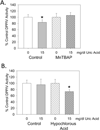Uric acid inhibition of dipeptidyl peptidase IV in vitro is dependent on the intracellular formation of triuret
- PMID: 24925478
- PMCID: PMC4107633
- DOI: 10.1016/j.yexcr.2014.05.025
Uric acid inhibition of dipeptidyl peptidase IV in vitro is dependent on the intracellular formation of triuret
Abstract
Uric acid affects endothelial and adipose cell function and has been linked to diseases such as hypertension, metabolic syndrome, and cardiovascular disease. Interestingly uric acid has been shown to increase endothelial progenitor cell (EPC) mobilization, a potential mechanism to repair endothelial injury. Since EPC mobilization is dependent on activity of the enzyme CD26/dipeptidyl peptidase (DPP)IV, we examined the effect uric acid will have on CD26/DPPIV activity. Uric acid inhibited the CD26/DPPIV associated with human umbilical vein endothelial cells but not human recombinant (hr) CD26/DPPIV. However, triuret, a product of uric acid and peroxynitrite, could inhibit cell associated and hrCD26/DPPIV. Increasing or decreasing intracellular peroxynitrite levels enhanced or decreased the ability of uric acid to inhibit cell associated CD26/DPPIV, respectively. Finally, protein modeling demonstrates how triuret can act as a small molecule inhibitor of CD26/DPPIV activity. This is the first time that uric acid or a uric acid reaction product has been shown to affect enzymatic activity and suggests a novel avenue of research in the role of uric acid in the development of clinically important diseases.
Keywords: CD26/DPPIV; Triuret; Uric acid.
Published by Elsevier Inc.
Figures




References
-
- Kaur H, Halliwell B. Action of biologically-relevant oxidizing species upon uric acid. Identification of uric acid oxidation products. Chem Biol Interact. 1990;73:235–247. - PubMed
-
- Robinson KM, Morre JT, Beckman JS. Triuret: a novel product of peroxynitrite-mediated oxidation of urate. Arch Biochem Biophys. 2004;423:213–217. - PubMed
-
- Gersch C, Palii SP, Imaram W, Kim KM, Karumanchi SA, Angerhofer A, Johnson RJ, Henderson GN. Reactions of peroxynitrite with uric acid: formation of reactive intermediates, alkylated products and triuret, and in vivo production of triuret under conditions of oxidative stress. Nucleosides Nucleotides Nucleic Acids. 2009;28:118–149. - PMC - PubMed
-
- Patschan D, Patschan S, Gobe GG, Chintala S, Goligorsky MS. Uric Acid Heralds Ischemic Tissue Injury to Mobilize Endothelial Progenitor Cells. J Am Soc Nephrol. 2007;18:1516–1524. - PubMed
Publication types
MeSH terms
Substances
Grants and funding
LinkOut - more resources
Full Text Sources
Other Literature Sources
Medical
Miscellaneous

